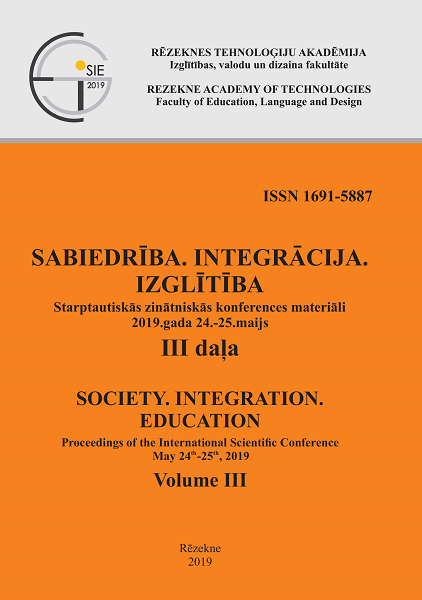THE FACTORS OF STUDENTS’ AGGRESSIVENESS IN ADOLESCENCE AND YOUTH
DOI:
https://doi.org/10.17770/sie2019vol3.3822Keywords:
aggressiveness, factors of aggressiveness, students, adolescence, youthAbstract
The article is devoted to the study of the actual problem of the aggressiveness of students within the walls of educational institutions, as evidenced by the growing statistics of tragic incidents in Russian schools and colleges in recent years. The subject of the research is the personal factors students’ aggressiveness from senior classes. The purpose of the research is a comparative study of personal factors, the focus of aggressiveness and the level of a conflictness of students in adolescence and youth.
A theoretical basis of the study is classical approaches to the understanding of aggressiveness as a personal construct of factors that determine readiness for aggressive manifestations of negative and positive orientation. For an empirical study 158 adolescents and young people (14–17 years old) were selected.
The method of organizing the investigation is an ascertaining experiment. The empirical data collection was carried out using the method of “Personal aggressiveness andconflictness” (E.P. Ilyin & P.A. Kovalev).
The results obtained allowed us to give a comparative description of the personal factors of aggressiveness, its focus and students’ conflictness levels in adolescence and youth. On the basis of the assumptions put forward about interiorization and socialization as two mechanisms for the development of aggressiveness, the author identified the most important aspects of psychological and educational prevention of aggressive behavior.
References
Allport, G.W. (1960). Personality and social encounter. Boston, MA: Beacon.
Bandura, A. (1983). Psychological mechanisms of aggression. In R. G. Geen and E. I. Donnerstein (Eds.), Aggression: Theoretical and empirical reviews (1-40). N.-Y.: Academic Press. Vol. 1.
Berkowitz, L. (1993). Aggression: Its causes, consequences, and control. N.-Y.: McGraw-Hill.
Buss, A.H. (1961). The psychology of aggression. N.-Y.: Wiley.
Conner, D.F. (2002). Aggression and antisocial behavior in children and adolescents: Research and treatment. N.-Y.: Guilford Press.
Dollard, J., Miller, N. E., Doob, L. W., Mowrer, O. H., & Sears, R. R. (1939). Frustration and aggression. New Haven, CT, US: Yale University Press.
Freud, S. (1961). Beyond the pleasure principle (J. Strachey, Ed.). New York, NY, US: W W Norton & Co.
Lorenz, K. (1963). On aggression. : Harcourt, Brace and World: New York.
Rogers, C.R. (1995). On becoming a person: a therapist's view of psychotherapy. Boston: Houghton Mifflin.
World Health Organization (2014). Global status report on violence prevention 2014.
Ильин, Е.П. (2014). Психология агрессивного поведения. СПб.: Питер.
Ильин, Е.П. (2013). Психология общения и межличностных отношений. СПб.: Питер.
Кириенко, А.А. (2014). Индивидуально-личностные особенности агрессивности подростков различных типов направленности личности: автореф. дис. ... канд. психол. наук. М.: РУДН.
Кобзева, О.В. (2006). Динамика агрессивности и ее взаимодействия с личностными особенностями в подростковом и юношеском возрастах: автореф. дис. … канд. психол. наук. М: ПИ РАО.
Налчаджан, А.А. (2007). Агрессивность человека. СПб: Питер.
Реан, А.А. (1996). Агрессия и агрессивность личности. Психологический журнал, № 5, 3–18.
Сафонов, В.К. (2003). Агрессия в спорте. СПб.: Изд-во С.-Петерб. ун-та.
Семенюк, Л.М. (1996). Психологические особенности агрессивного поведения подростка и условия его коррекции. Москва-Воронеж : МПСИ : МОДЭК.
Сенько, Т.В. (2002). Психология взаимодействия: ч. 4. Истоки агрессивного поведения детей. Минск: Карандашев.
Случаи нападений в российских школах в 2017-2018 годах. Досье.Retrieved from https://tass.ru/info/4885783
Фурманов, И.А. (1996). Детская агрессивность. Минск: Ильин В.П.






